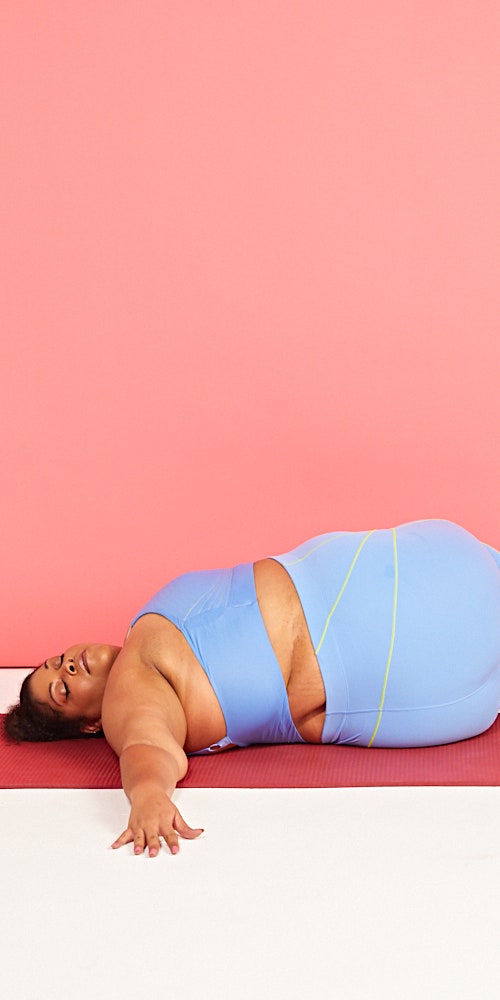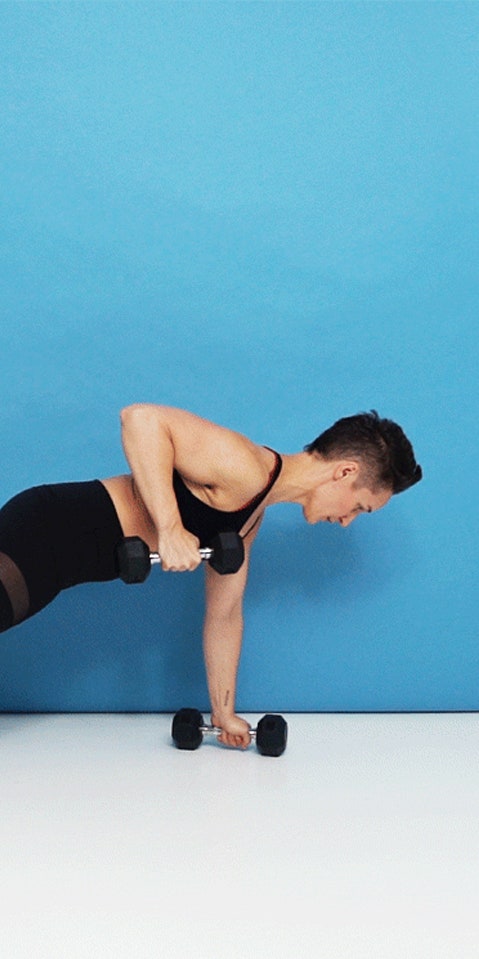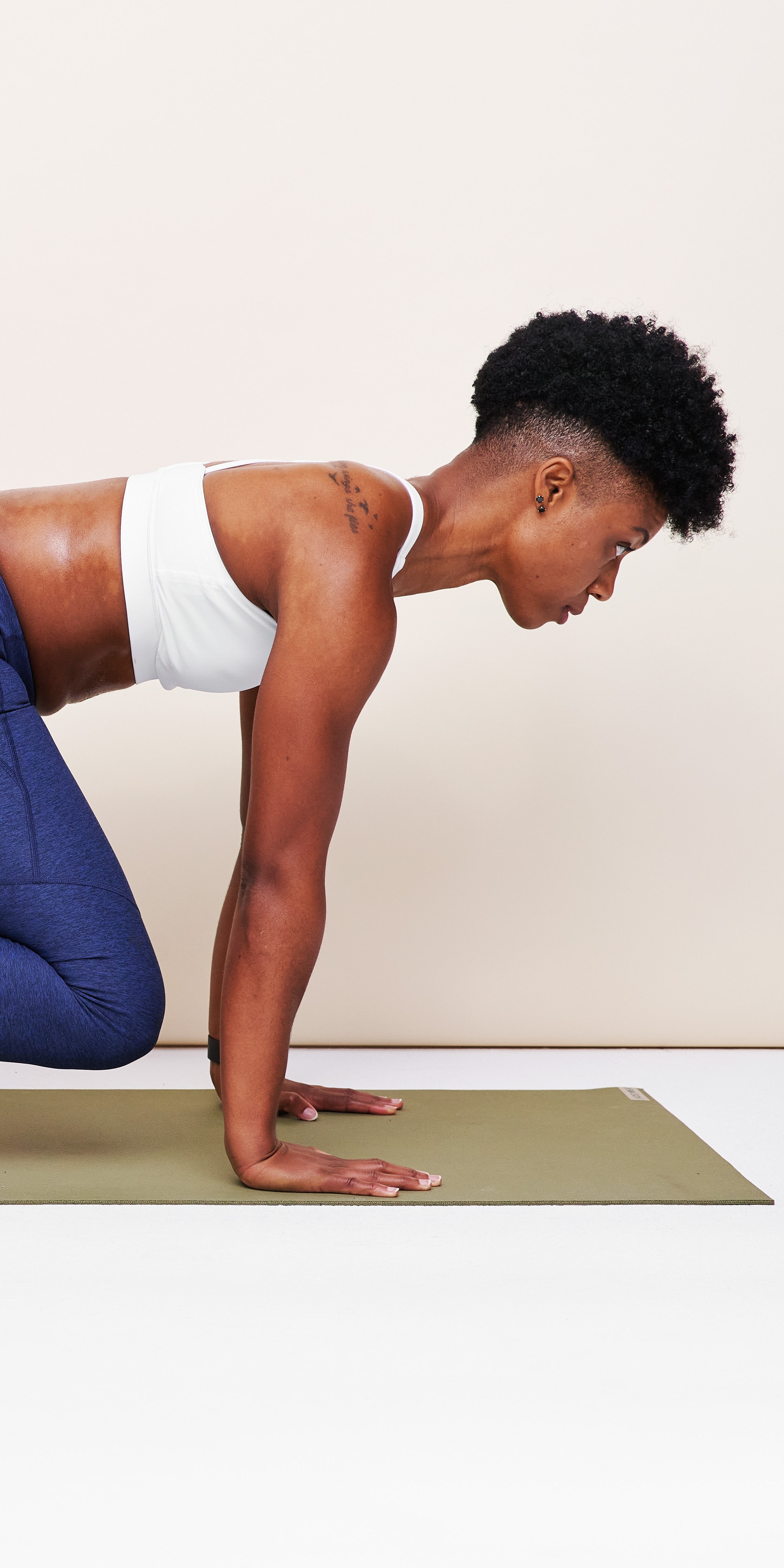
If you’re looking for some gentle movement to start your day, a yoga core workout might be the wake-up sequence you need.
Whether you’re the type to hit the ground running first thing in the morning or the type to hit the snooze button instead, there are definitely benefits to adding a gentle morning movement sequence into your mix. For one thing, it helps you reset if you’re the hard-charging type—and brings up your energy if you’re not.
Another big bonus: Even gentle movement can have notable effects for your core, the part of your body that helps stabilize you to lift heavier weights during your workout and perform everyday tasks like bending and twisting more easily. So while you might not exactly feel like powering through a sweaty HIIT core workout when you’re still rubbing sleep from your eyes, moving your body with intention—focusing on form and breath—with a yoga-inspired sequence can also activate your core muscles, from your abs to your obliques to your lower back.
A yoga-inspired sequence can not only get your mind in the right place for the day; it can also give you all the advantages of a stronger core, such as better posture, more energy, and a higher degree of body awareness, Marcia Denis, D.P.T., a Miami-based physical therapist, certified yoga teacher, and cohost of the Disabled Girls Who Lift podcast, tells SELF. Plus, there are also tons more benefits of yoga—everything from improving lower back pain to building stronger muscles and improvising balance, as SELF reported previously.
As long as you’re connected to your breath and staying present in your movements, you’re doing yoga, Dr. Denis says. So while you may not recognize all of the moves below as specific yoga poses, they’re still serving a similar role. The main cue in a gentle, mobility-based routine like this is to cultivate a sense of joy and appreciation as you’re moving—feelings that should be fueling your purpose as well as your practice.
In this yoga core workout that Dr. Denis created, not all of the moves are core specific, but they all involve some level of stabilization, which activates your core to keep your body in proper alignment. You’ll have a suggested number of reps and breaths for each move, but go with what feels right for you. If your core is loving the ideas of more reps on one sequence, listen to your body. And as always, these should be done slowly and with intention—if you find yourself moving too fast and getting into sweaty territory, consider that a cue to back off and slow down.
The Workout
What you need: A yoga mat for comfort. Yoga blocks for modification can also be helpful.
Exercises
- Cat-Cow
- Downward-Facing Dog
- Down Dog Abs
- Plank
- Side plank
- Child’s Pose
- Boat Pose
- Reclining spinal twist
- Reclining Pigeon Pose
Directions
- Hold each pose for the specified amount of time or reps, going from one to the next without rest. (Of course, if you need time to reset, take what you need.) Try to focus on your breath to bring intention to each move.
Demoing the moves below are Shauna Harrison (GIF 1), a San Francisco Bay Area trainer, yogi, public health academic, advocate, and columnist for SELF; Caitlyn Seitz (GIF 2), a New York–based group fitness instructor and singer-songwriter; Cookie Janee (GIF 3), a background investigator and security forces specialist in the Air Force Reserve; Erica Gibbons (GIF 4), a California personal trainer and graduate student becoming licensed as a marriage and family therapist; Amanda Wheeler (GIF 5), a certified strength and conditioning specialist and cofounder of Formation Strength; Jessica Rihal (GIFs 6, 8, 9), a plus-size yoga instructor (200-HR) and a strong advocate of fitness and wellness for all bodies; and Crystal Williams (GIF 7), a group fitness instructor and trainer in New York.
-
Pinterest
Kelsey McClellan1 Cat-Cow
- Start on all fours with your shoulders over your wrists and hips over knees.
- Take a slow inhale, and on the exhale, round your spine and drop your head toward the floor (this is the “cat” posture).
- Inhale and lift your head, chest, and tailbone toward the ceiling as you arch your back for “cow.”
- Continue for 1 to 3 minutes.
The Cat-Cow move helps relieve tension in your lower back, which is considered part of your core. If your knees are bugging you during the pose, add blankets or towels for extra cushion. If your wrists feel uncomfortable, try doing wrist circles before the pose, or put your elbows on a step or blocks instead.
-
Pinterest
Katie Thompson2 Downward-Facing Dog
- Start in tabletop position with your shoulders stacked directly over your wrists and hips over your knees.
- Spread your hands wide and press your index finger and thumb into the floor.
- Inhale to tuck your toes. Exhale to push your tailbone up towards the ceiling as you straighten your legs as best as you can. (You can bend your knees if you need to get your heels closer to the ground.)
- Relax your jaw and face as you gaze toward your belly button.
- Hold the position for five breaths.
If you struggle with relaxing your jaw and face in this position, try shaking your head “yes” and “no” to release some of the stress, says Dr. Denis. To make this less intense, you can put your hands on a wall or a step to decrease the intensity of the inversion.
-
Pinterest
Katie Thompson3 Down Dog Abs
- Start in Downward-Facing Dog, with your hands shoulder-width apart, butt lifted back and toward the ceiling, legs straight, arms extended, back flat, and your head in between your arms. Lift your right leg into the air to get into Down Dog Split (Three-Legged Down Dog).
- Bend your right knee and bring it in toward your right elbow, moving your torso into a plank position as you do. Pause, then extend your right leg back and up into Down Dog Split.
- Next, bring your right knee under and across your torso toward your left elbow. Pause, then extend your right leg back and up into Down Dog Split. That’s 1 rep.
- Do 5 reps on one leg, and then repeat on the other leg.
This dynamic version of the Downward Dog targets your core (including your obliques) while challenging your shoulder stabilizers. Plus, your mobility will get a boost too.
-
Pinterest
Kelsey McClellan4 Plank
- Start in Downward-Facing Dog. Inhale and shift your body weight forward into plank pose. Move your feet and hands as needed so your wrists are stacked under shoulders and knees under your hips.
- Exhale and fix your gaze to the floor to keep your spine neutral from neck to tailbone.
- Hold this position for three breaths.
To make this easier, you can modify the high plank with your knees down or a forearm plank on your elbows. Aim for one straight line from head to toe with any variation you choose, Dr. Denis says. By firing your core throughout the move, you’re really challenging all of those stabilizing muscles.
-
Pinterest
Katie Thompson5 Side Plank
- Position yourself on your right side with your right hand directly underneath your right shoulder. Extend your legs and stack your left foot on top of your right, and then squeeze your abs and glutes to lift your hips off the floor. Extend your left hand straight up toward the ceiling.
- Hold here for two breaths. On the exhale, return your left hand to the floor.
- Repeat on the other side.
The side plank really works your obliques; plus, it helps improve shoulder stability. To decrease the intensity of this move, try doing a side plank on your forearm with your knee down.
Most Popular
- 5 Less Obvious Signs of Seasonal Depression You Should Definitely Pay Attention To
By Maggie O’Neill
- 42 Creative Valentine’s Day Gifts for Guys
By Sarah Madaus
- Just Some Fun Sex Toys You and Your Partner Will Love
By Gabrielle Kassel
-
Pinterest
Meiko Arquillos6 Child’s Pose
- Sit back on your heels with your knees out wide.
- Bend forward at the hip and lower your chest between your thighs and let your forehead rest on the ground.
- Extend your arms to the front and place your palms on the ground.
- Hold for 30 seconds.
If your glutes don’t reach your heels or you feel discomfort anywhere, you can play around with blankets and cushions to reduce the range of motion and make the move easier.
-
Pinterest
Katie Thompson7 Boat Pose
- Sit up straight with your legs bent, feet flat on the floor.
- Keeping your legs together, slowly lift them until they form a 45-degree angle to your torso. Engage your entire core, keep your back flat, and balance on your tailbone.
- You can keep your knees bent (as pictured) or straighten them out for more of a challenge.
- Reach your arms straight out in front of you, parallel to the floor. If you feel that you need some extra support, place your hands on the floor, underneath your hips.
- Hold here for 30 seconds to 1 minute.
The boat pose is an isometric exercise—meaning without movement—that really fires up your core. To make it harder, straighten your legs. To make it easier, place your feet on a wall or blocks instead of trying to hold them above the ground, says Dr. Denis. You can also rest your feet on the floor as needed for a few seconds during the move.
-
Pinterest
Meiko Arquillos8 Reclining Spinal Twist
- Lie on your back. Hug your knees into your chest, keeping your chest as square to the ceiling as you can.
- Then, drop both knees over to one side as you twist your torso in the opposite direction. Try to keep your knees and hips in line with each other as you draw them toward the floor
- Hold this position for 1 to 3 minutes, and then repeat on the other side.
If your knee doesn’t hit the ground when you twist, you can place a blanket or block to make up the space, reduce your range of motion, and increase the comfort level, says Dr. Denis. As with any twisting motion, this is especially effective for working your obliques.
Most Popular
- 5 Less Obvious Signs of Seasonal Depression You Should Definitely Pay Attention To
By Maggie O’Neill
- 42 Creative Valentine’s Day Gifts for Guys
By Sarah Madaus
- Just Some Fun Sex Toys You and Your Partner Will Love
By Gabrielle Kassel
-
Pinterest
Meiko Arquillos9 Reclining Pigeon Pose
- Lie on your back. Cross your right foot over your left quad, and bend your left knee.
- Hold the back of your left leg and gently pull it toward your chest.
- When you feel a comfortable stretch, hold there for 1 to 3 minutes.
- Switch sides and repeat.
This pose (also known as the figure-four stretch) can be super passive or more active. If you’re looking for more chill, hold as stated or place your left foot on a wall. If you’re looking for more work, reach behind your thigh (as pictured) and pull your knee toward you. Because your abs will work to keep your legs off the ground, you’ll get some gentle core work here.















